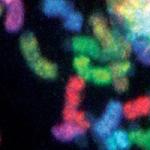
Ying E. Zhang, Ph.D.
Senior Investigator
Laboratory of Cellular and Molecular Biology
NCI/CCR
Research Topics
TGF-beta and its related factors regulate a broad range of cellular functions, including proliferation, differentiation, apoptosis, migration and adhesion, and play very important roles in cancer and many other diseases. Our research focuses on three aspects of TGF-beta signaling in an attempt to gain further appreciation of its regulation, mechanisms of action and function in development and tumorigenesis. In order for proper TGF-beta signaling, the activity of Smad proteins is subject to stringent control, allowing alterations in the biological effects of ligands. A key event that regulates R-Smad activity is phosphorylation. Smad3 can be phosphorylated on cue of TGF-beta in the linker region in addition to the two C-terminal Ser residues. The linker sites are also phosphorylated by MAPK and CDK in response to mitotic signals. Previously, we created mouse liver cancer models by forced expression of Smad3 tissue-specifically in the liver using the Tet-off inducible system. we found that up-regulating Smad3 protects the liver against carcinogenic insult, and demonstrated that this tumor-protective role is afforded by the ability of Smad3 to down-regulate Bcl-2 transcription via p38 kinase (Cancer Cell 2006). This finding offers a new insight into designing novel approaches for treating the liver cancer. Recently, we discovered that Smad3 not only regulates transcription but also alternative splicing in the nucleus, which facilitates cancer progression by stimulating EMT and invasion (Molecular Cell 2016).
The second area of our research focused on the regulation of TGF-beta signaling modulators by ubiquitination, particularly the ubiquitin modification catalyzed by Smurf1 and Smurf2, which are HECT-domain E3 ligases. Resorting to mouse genetic approaches, we generated knockout alleles of both Smurf1 and Smurf2 genes to address their roles under physiological conditions. We found that Smurf1 and Smurf2 have both common and unique functions during embryogenesis and in maintaining adult physiological homeostasis. Our earlier work on characterizing Smurf1 knockout mice revealed a novel function of Smurf1 in the regulation of osteoblast function and bone homeostasis (Cell 2005), suggesting that targeting Smurf1 may prove to be an effective strategy for treating age-related bone losses in osteoporosis. Our recent work on characterizing Smurf2 knockout mice clarified contradictory reports in the literature about Smurf regulation of TGF-beta signaling by showing that Smurf2 indeed has an inhibitory role, but it does so by attenuating Smad3 activity through mono-ubiquitination rather than promoting its degradation as previously reported (EMBO J 2011). Our study also led to an unexpected discovery of a previously unrecognized function of Smurf2 as a tumor suppressor that normally maintains genomic stability by controlling epigenetic landscape of histone modifications via RNF20 (Nature Medicine 2012).
Finally, although Smads are involved in most actions of the TGF-beta superfamily, activated TGF-beta receptors also transduce signals through other intracellular signaling pathways, especially those mediated by MAP kinases (EMBO J. 2012). The third area of research of our research focuses on the specific mechanism by which TGF-beta receptors activate non-Smad pathways, and the biological significance of these Smad-independent pathways in TGF-beta signaling. Previously, we identified TRAF6 as the mediator of Smad-independent signaling conduit that exerts its control of downstream gene expression via activation of the JNK/p38 kinase (Molecular Cell 2008). Currently we are working to identify other downstream mediators that are responsible for Smad-independent TGF-beta receptor signaling using SILAC-based proteomic approaches. These studies could uncover novel molecular mechanisms that account for a number of Smad-independent TGF-beta signaling responses, and shed light on a decade-old puzzle of why tumor cells, which often develop a resistance to TGF-beta-induced growth inhibition as they progress, can retain an otherwise functional TGF-beta signaling pathway.
Biography
Dr. Ying Zhang received her B.S. degree in Chemistry and M.S. degree in Biochemistry from Peking University, China. She obtained her Ph.D. degree from University of Wisconsin-Madison in 1995 and completed her postdoctoral training with Dr. Rik Derynck in University of California, San Francisco. She joined the Laboratory of Cellular and Molecular Biology in 2000 as a tenure-track investigator and became a senior investigator in 2007.
Honors and Awards
Dr. Zhang was elected as an American Institute For Medical and Biological Engineering (AIMBE) Fellow in 2020 and an American Association for the Advancement of Science (AAAS) Fellow in 2021. She was also a recipient of several awards throughout her career at NIH, including the NCI Director’s Innovation Award (2006), the NCI Merit Award (2007), the NIH APAO Outstanding Scientific Award (2011) and the NCI Outstanding Mentor Award (2016).
Selected Publications
- Tripathi V, Sixt KM, Gao S, Xu X, Huang J, Weigert R, Zhou M, Zhang YE. Direct Regulation of Alternative Splicing by SMAD3 through PCBP1 Is Essential to the Tumor-Promoting Role of TGF-β. Mol Cell. 2016;64(3):549-564.
- Blank M, Tang Y, Yamashita M, Burkett SS, Cheng SY, Zhang YE. A tumor suppressor function of Smurf2 associated with controlling chromatin landscape and genome stability through RNF20. Nat Med. 2012;18(2):227-34.
- Yamashita M, Fatyol K, Jin C, Wang X, Liu Z, Zhang YE. TRAF6 mediates Smad-independent activation of JNK and p38 by TGF-beta. Mol Cell. 2008;31(6):918-24.
- Yang YA, Zhang GM, Feigenbaum L, Zhang YE. Smad3 reduces susceptibility to hepatocarcinoma by sensitizing hepatocytes to apoptosis through downregulation of Bcl-2. Cancer Cell. 2006;9(6):445-57.
- Yamashita M, Ying SX, Zhang GM, Li C, Cheng SY, Deng CX, Zhang YE. Ubiquitin ligase Smurf1 controls osteoblast activity and bone homeostasis by targeting MEKK2 for degradation. Cell. 2005;121(1):101-13.
Related Scientific Focus Areas




Molecular Biology and Biochemistry
View additional Principal Investigators in Molecular Biology and Biochemistry

This page was last updated on Thursday, December 4, 2025